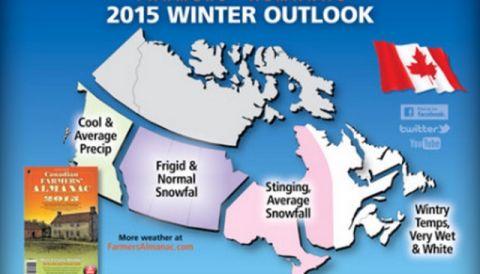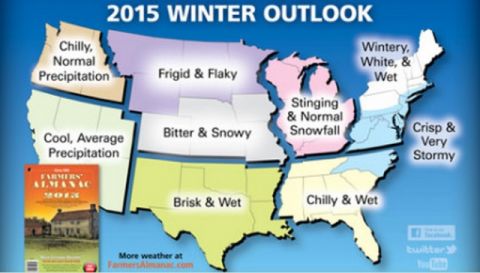2015 Winer weather predictions from the Farmers Almanac

After a short, cool summer, most Canadians can expect yet another harsh winter.
That's the forecast according to the Old Farmer's Almanac, which is predicting Ontario and the Prairies will experience below-average temperatures this winter, while snowfall in the Prairie provinces, as well as southern Quebec and the Ottawa area, "will be much greater than normal."
"In 2015, the seasons will bring fierce conditions almost everywhere," Janice Stillman, editor of The Old Farmer's Almanac, said in a release about the Canadian forecast.
Only Atlantic Canada and - unsurprisingly - southern British Columbia, will have above-normal temperatures as well as below-normal snowfall.
Most everyone will experience a cool spring, but after that, Canadians are in for a good summer.
The almanac, which has been published for 223 years, says it has an 80% success rate in accurately predicting long-range weather forecasts.
Fall 2015 will bring average or slightly warmer-than-normal temperatures to much of Canada, and below-normal precipitation everywhere but in the Prairies and the Yukon, where it will be wetter than normal.

And for the USA…
The United States is in for another long, cold winter, according to the newest edition of the Farmers' Almanac. But before you get out your snow shovel and fuzzy mittens, keep reading. Expert meteorologists say the nearly 200-year-old publication's foreboding forecast may be mistaken.
The 2015 edition of the Farmers' Almanac hit shelves Aug. 25, and its contents aren't heartwarming for the winter-weary. This winter will see "below-normal temperatures for about three-quarters of the nation," the Almanac reads. The new winter outlook also predicts that the Northern Plains and the Great Lakes regions of the U.S. will be hardest hit. A snowy winter is predicted for the eastern coastal part of the country, as well as the Central and Southern Plains.
But these forecasts could be wrong, according to Anthony Artusa, a meteorologist with the National Oceanic and Atmospheric Administration's (NOAA) Climate Prediction Centre in College Park, Maryland.
"One of the things that we look for is whether we have an El Niño or La Niña in place," Artusa said. But these complex weather patterns, which result from variations in ocean temperatures in the Pacific Ocean, are not present at the moment, he said.








